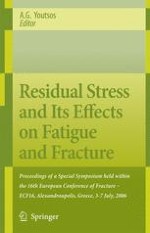2006 | OriginalPaper | Buchkapitel
Effects of Residual Stresses on Crack Growth in Aluminum Alloys
verfasst von : B. Kumar
Erschienen in: Residual Stress and Its Effects on Fatigue and Fracture
Verlag: Springer Netherlands
Aktivieren Sie unsere intelligente Suche, um passende Fachinhalte oder Patente zu finden.
Wählen Sie Textabschnitte aus um mit Künstlicher Intelligenz passenden Patente zu finden. powered by
Markieren Sie Textabschnitte, um KI-gestützt weitere passende Inhalte zu finden. powered by
It is well known that mechanical surface treatments such as shot peening can significantly improve the fatigue behavior of highly stressed metallic components. This increase in fatigue and corrosion performance occurs because of the thin layer of residual stresses created by the shot peening process. Literature [1, 2 & 3] is replete with information on the increase in fatigue life with peening but there is little information in open literature on the crack initiation and growth in the shot peened materials. The measurement of fatigue crack growth through this layer of compressive stress field which is less than 0.01” (∼ 0.6mm) thick is a challenge. The present study highlights the attempts to detect crack initiation and measure crack growth in the heavily deformed surface layers, using several measurement techniques of the following aluminum alloys: 7050-T7451 & 7075-T7351. To produce specimens with short cracks several specimen geometries proposed by Suresh & Ritchie [3] were prospected and after several tests it was found that the hourglass coupon with a scratch, the Eccentrically Loaded Single Edge Notched Coupons ESE(T) coupons and the double edge notch coupons DENT(T) similar to the one used by Everett et al [4] would be most appropriate. Several measurement techniques were used in order to detect crack initiation in the hourglass coupons. It was found that the ACPD and eddy current methods were more reliable than the non-contact surface measurement techniques used. The ESE(T) coupons were used to determine the effects of shot peening on crack growth rates, and the results indicate that the effects of peening did not sufficiently retard crack growth for the specimen geometry chosen. Currently work is being conducted to fabricate specimens such that the initial crack is fully embedded in a zone of compressive stresses using the DENT(T) specimen geometry. Understanding the influence of compressive residual stresses and how it affects the fracture mode is central to any investigation on how it may be utilized to improve fatigue resistance of the material. Thus, quantifying and measurement of the residual stress field was also conducted to help better understand its influence on crack growth.
